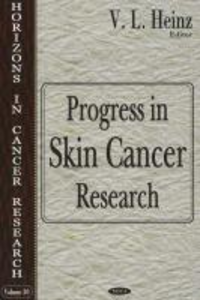The incidence of Melanocytic Naevi (moles) in young children
Harrison, Simone Lee, and MacLennan, Robert (2006) The incidence of Melanocytic Naevi (moles) in young children. In: Heinz, V.L., (ed.) Progress in Skin Cancer Research. Horizons in Cancer Research, 30 . Nova Science Publishers, New York, USA, pp. 41-64.
|
PDF (Published Version)
Restricted to Repository staff only |
||
![[img]](https://researchonline.jcu.edu.au/1637/2.hassmallThumbnailVersion/1637_Harrison_%26_MacLennan_2006.jpg)
|
Image (JPEG)
- Cover Image
Download (7kB) |
Abstract
Background: The number of melanocytic naevi (moles) a person develops is an important phenotypic risk factor/marker for cutaneous melanoma. Studies of migrants to Australia suggest that avoidance of strong sun exposure in childhood decreases adult risk of melanoma. An understanding of the relation of sun exposure in early childhood to the occurrence of naevi may increase our understanding of melanocytic neoplasia.
Methods: The development of melanocytic naevi was assessed longitudinally in a cohort of 115 Caucasian neonates who were born in Townsville, Queensland, Australia (latitude 19°16'S) in the Spring of 1994. These children were examined for melanocytic naevi at birth, and at 6, 12, 18, 24, and 36 months of age. An experienced observer used a standard international protocol. Melanocytic naevi of all sizes were recorded by size and body site. Sun exposure was assessed by regular parental questionnaires.
Findings: The proportion of children with melanocytic naevi increased rapidly in the first 2 years of life from 2.3% at birth to 10.8% at 6 months, 65.2% at 12 months, 92% at 18 months and 100% at 24 months. The median rate of acquisition of incident melanocytic naevi in these children was 1 [IQR 0, 2] in the first year, 5 [IQR 3, 8] in the second year and 6 [IQR 4, 10] in the third year of life. Children who began acquiring melanocytic naevi before 12 months of age had significantly more naevi at 36 months of age than children who developed their first naevus during their second year of life (median number of additional naevi acquired between 12 and 36 months was 13 versus 8, respectively; WRS p=0.0082). Children who began acquiring melanocytic naevi in the first year of life also played outside in the sun more often than children who began developing naevi later on (χ2 1 df: p = 0.048). Melanocytic naevi were most concentrated on the upper limbs, followed by the head and neck of these children across all ages. In contrast, low relative densities of melanocytic naevi were found on the sun-protected surface of the trunk and the relative excess concentration of melanocytic naevi found on the lower limbs of 12 month-old children diminished with age.
Interpretation: These results provide further evidence for the role of sun exposure in the development of melanocytic naevi. It is possible that the age of onset of melanocytic naevus development may influence the risk of melanoma.
| Item ID: | 1637 |
|---|---|
| Item Type: | Book Chapter (Research - B1) |
| ISBN: | 978-1-60021-095-2 |
| Keywords: | nevi; naevi; melanocytic; sun; child; neonate; cohort; mole; nevus; naevus; skin; melanoma; Queensland; tropics; Australia; exposure; ultraviolet; UV |
| Related URLs: | |
| Date Deposited: | 05 Sep 2007 |
| FoR Codes: | 11 MEDICAL AND HEALTH SCIENCES > 1117 Public Health and Health Services > 111706 Epidemiology @ 100% |
| SEO Codes: | 92 HEALTH > 9201 Clinical Health (Organs, Diseases and Abnormal Conditions) > 920117 Skin and Related Disorders @ 40% 92 HEALTH > 9201 Clinical Health (Organs, Diseases and Abnormal Conditions) > 920102 Cancer and Related Disorders @ 40% 92 HEALTH > 9205 Specific Population Health (excl. Indigenous Health) > 920501 Child Health @ 20% |
| Downloads: |
Total: 348 Last 12 Months: 1 |
| More Statistics |



